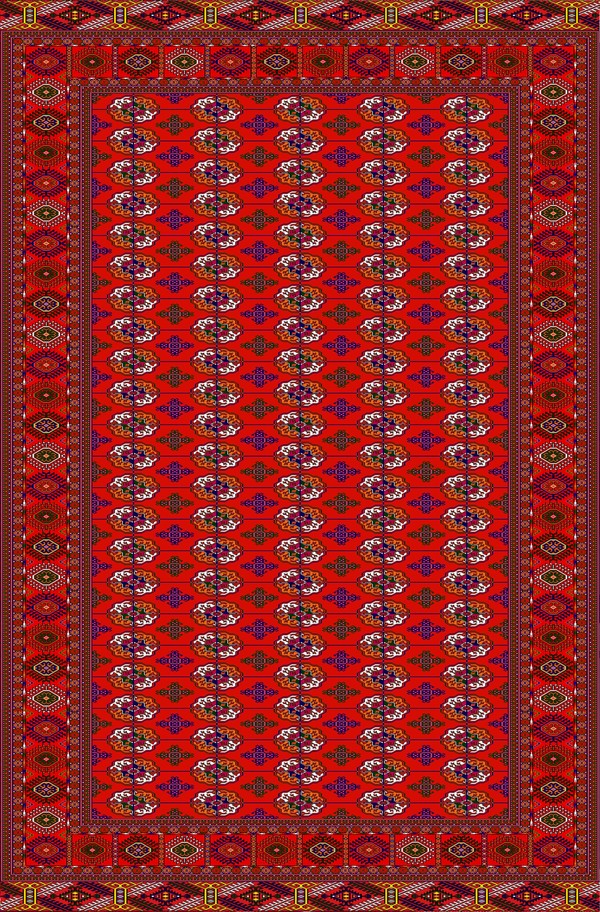
[아츠앤컬쳐] 카펫 공예는 투르크멘인의 삶에서 중요한 위치를 차지한다. 기원전 3천년 신석기시대 유물에서도 오늘날 투르크멘 카펫의 문양과 유사한 도안을 찾아볼 수 있다. 투르크멘 여성들은 노란 양털을 주재료로 하여 식물에서 얻은 다양한 색상의 염료를 써서 카펫을 직조하였다. 카펫 문양의 주요 부분은 ‘오르나멘트’라고 하는데, 여기에 투르크멘 부족의 아름다움과 독특함이 두드러진다.
투르크멘 전통 카펫 공예의 패턴 장식의 형태와 내용은 오랜 세월에 걸쳐 안정되어 왔다. 카펫의 중앙부에 오르나멘트를 배치한 후 테두리 문양, 우주, 흙, 그리고 프린지를 만든다. 투르크멘 카펫은 외관과 복잡한 내부 시스템을 오랫동안 보존해 온 공예로, 그 자체로 ‘고전’으로 간주되며, 전통 카펫은 일반적으로 부족 단위에서 만든다. 투르크멘 카펫은 세계에서 가장 오래되고 안정적인 패턴 시스템인 오르나멘트로 디자인되었다. 중앙의 오르나멘트는 가변성이 낮은 문양으로, 이는 패턴의 중요성을 보여준다. 카펫 오르나멘트의 수직 및 수평 배열과 반복 및 내부 패턴의 독특한 구조는 이 공예가 고대 공예에 속함을 나타낸다.
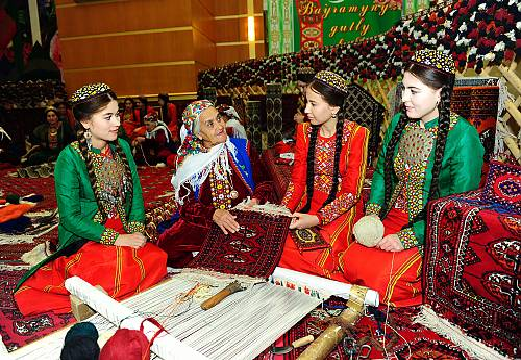
투르크멘 여성들은 자연을 문양으로 옮겨 묘사하며 조화로운 색조의 일관성을 유지할 수 있었고, 그들이 창조한 색상은 투르크멘 전통 회화 학교의 기초가 되었다. 색상은 카펫과 회화에서처럼 차가운 색과 따뜻한 색으로 나뉘는데, 연노랑에서 진갈색, 그리고 연초록에서 진파랑까지 다양하다. 물론 투르크멘 카펫에서 색상의 채도와 밝기는 잘 고려된다. 카펫 공예에서 색상은 매우 밝고 풍부하다. 그 화법 경향과 조화 즉, 회화의 흐름을 비교하는 것이 중요하다. 투르크멘 카펫에서 고전학파의 “새 오르나멘트”, “부싯돌 오르나멘트”, “아이나 커챀”, “케제베 오르나멘트”, “앨렘-자한”, “다섯 달”과 같은 문양을 예로 들 수 있다. 이러한 화려한 카펫에서는 중앙 패턴이 카펫의 조화를 더해준다.
하지만 실제로는 다양한 문양으로 만들어진 카펫도 많이 있다. 이 예들은 순간적인 아름다움(인상주의)으로 요약된다. 투르크멘 카펫에서 자연 속에서 활동하는 “밀”, “샤의 재산”, “솀샤트 오르나멘트”, “이읠란 베시리”, “갑사 패턴”, “손톱 패턴”과 같은 패턴은 중앙에서 양쪽으로 이동한다. 이것은 카펫의 가장자리, 우주의 프레임을 넘어서 계속해서 움직인다.
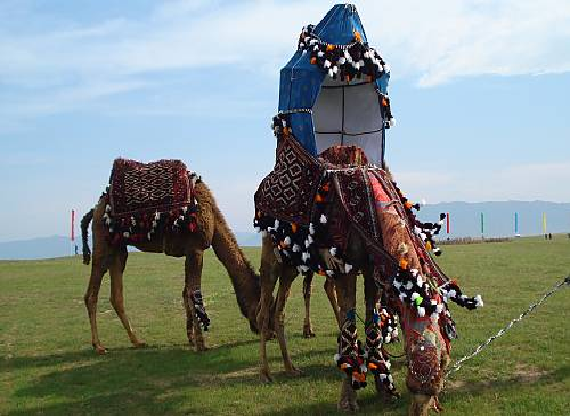
카펫의 예술적 특성에서 색상이 중요한 역할을 한다는 점을 강조할 필요가 있다. 카펫은 빨간색부터 갈색, 초록색, 파란색, 흰색 순서로 사람들에게 영향을 미친다. 미술에서는 예술가들이 색상을 따뜻한 색과 차가운 색, 밝은 색과 어두운 색, 채도가 낮은 색과 높은 색, 칙칙한 색과 차분한 색 등 여러 그룹으로 나눈다. 현대는 투르크멘 회화 예술 학교를 기반으로 투르크멘 카펫의 풍부한 색상을 얻을 수 있었고, 그 색채의 조화는 19세기 말과 20세기 초에 등장한 서양 예술의 모더니즘 흐름에 영향을 미쳤을 가능성이 있다.
투르크메니스탄에서 카펫 축제는 매년 5월 마지막 일요일에 국제적인 수준의 학술회의와 전시회 형태로 국가적 자부심을 가지고 기념되고 있다. 2019년, ‘투르크메니스탄의 전통 카펫 제작 공예’가 유네스코의 인류 무형문화유산 목록에 등재되었다.
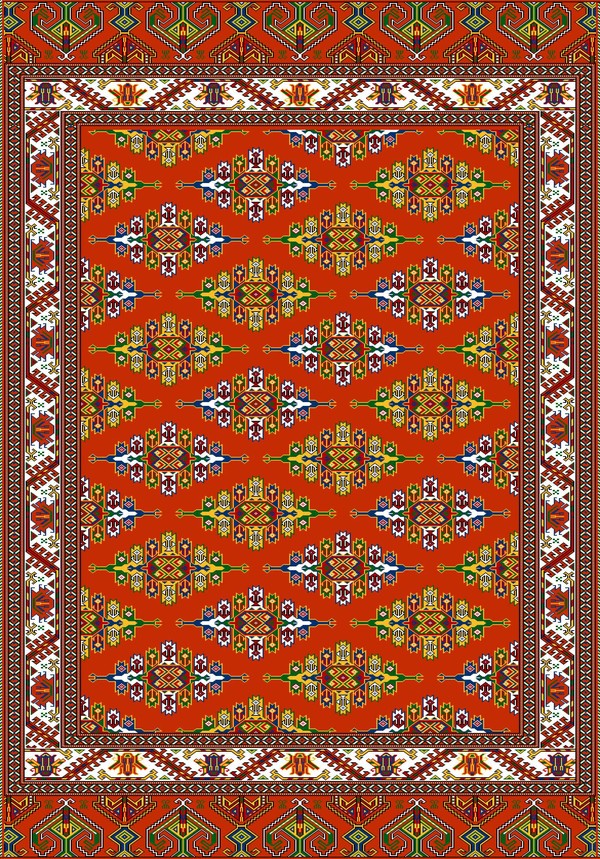
THE IMPORTANT ROLE AND SIGNIFICANCE OF COLORS IN TURKMEN CARPET ART
The art of carpet weaving occupies an important place in the life of the Turkmen people. From the Eneolithic period, that is, in the 3rd millennium BC, we can see drafts that are similar to some of the patterns in modern Turkmen carpets. Carpets were woven by Turkmen women. The main material of the carpet is the wool of the Turkmen yellow sheep, and different colored dyes are obtained from local plants. The main part of the carpet pattern is called "ornament". These ornaments define the beauty uniqueness of the Turkmen tribes.
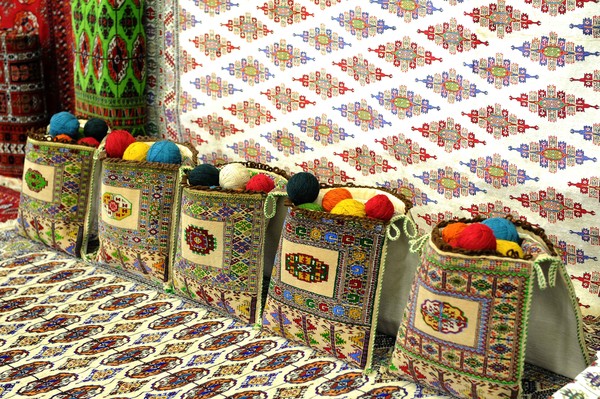
The form and content of the pattern decorations of Turkmen national carpet art have been more stable over the centuries. Ornaments are placed in the central area of the rugs, then the border pattern, the universe, the soil and the fringe are placed. Turkmen carpets are an art that has preserved its external appearance and a complex internal image system of patterns for a long time, which is considered to be its own "classic". National rugs are generally tribal rugs. Turkmen rugs are designed by ornaments, the world's oldest and most stable pattern system. An ornament is a slightly variable image located in the central area of the carpet. This shows that it is given special importance. The placement of carpet ornaments in vertical and diagonal rows and repeating many times, the distinctive structure of the inner patterns of the ornament is a sign that it belongs to ancient art.
Turkmen women could keep the overall color of the carpets in harmony by transferring nature into patterns. The colors created by them are the foundations of the national school of Turkmen painting.

Colors are divided into cool and warm categories, just like in carpets and paintings. They range from light yellow to dark brown, and from light green to dark blue. Of course, the saturation and lightness of colors in Turkmen carpets is considered well.
Colors are richly brilliance in carpet art. It is important to compare his school and his harmony with the currents of painting. Turkmen carpets with patterns such as "Bird ornament", "Chakmak ornament", "Ayna gochak", "Kejebe ornament", "Alem-Jahan", "Five Moons" can be examples of the classical school. In such colorful rugs, the central patterns add to the harmony of the rug.
But there are many other examples of art in action includes patterned carpets. They are summarized as a momentary beauty (The Impressionism Stream). Nature in action Turkmen carpets’ patterns like "Wheat", "King property", "Shemshat ornament", "Yylan beshir", "Gabsa pattern", "Nail pattern ", ornaments move from the center to both sides of the carpets. Those signs despite of the edge of the carpet, the frame of the universe, they continue to act.
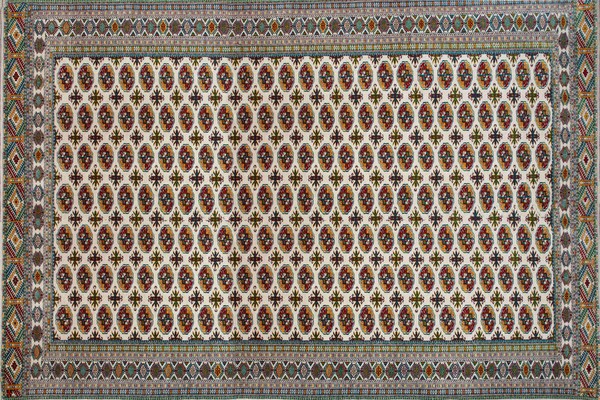
It is important to emphasize that colors play an important role in the artistic character of the carpet. Red carpets can influence people's attitude in the first, brown carpets in the second, green carpets in the third, blue carpets in the fourth, and white carpets in the fifth level.
In fine arts, artists divide colors into several groups such as: "warm" and "cool", "light" and "heavy", "unsaturated " and "saturated", "dull" and "subdued", and etc.
The color wealth of Turkmen carpets is concentrated on the basis of the national school of Turkmen painting art. Its color harmonies may have had an influence on the modernism trends in the art of Western countries that emerged at the end of the 19th century and the beginning of the 20th century.
The carpet festival in Turkmenistan is celebrated with national pride on the last Sunday of May every year in the form of scientific conferences and exhibitions at the international level.
In 2019, "National Carpet Art of Turkmenistan" was included in UNESCO's List of Intangible Cultural Heritage of Humanity.

글 ㅣ Nuryagdy Yagshymyradov
Deputy of for scientific affairs of the State Academy of Arts of Turkmenistan
Candidate of arts studies

